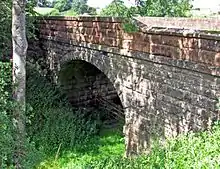Historical Railways Estate
The Historical Railways Estate (HRE) is a group of over 3,200 structures—predominantly bridges, but also including tunnels, embankments, and other works—associated with former railways in the United Kingdom. The structures are owned by the Department for Transport (DfT) and managed by National Highways (NH). Controversially, NH has proposed to demolish or infill dozens of bridges.
Background
The railways came into public ownership as a result of the Transport Act 1947. When they were privatised in 1997, operational infrastructure became the responsibility of Railtrack and then Network Rail. The Historical Railways Estate is the land and infrastructure associated with closed lines. This transferred to BRB (Residuary) Limited, which was dissolved in 2013, and the HRE was transferred to the Highways Agency, which later became Highways England (HE) and then National Highways (NH).[1][2]
NH states that the HRE comprises 2,055 bridges, 152 tunnels, 93 viaducts and aqueducts, 643 partially dismantled structures, 181 earthworks, and 106 other sites. The miscellaneous sites include plots of land, former roads, and monuments or memorials built by railway companies. The vast majority of the structures, 2,243, are in England; 608 are in Scotland, and 379 are in Wales; 77 of the structures are listed buildings.[3][2]
Restorations
NH is funded only to maintain the structures in a safe condition, but has worked with other organisations to restore and repurpose some. Examples include Castlefield Viaduct in Manchester, which the National Trust is converting into an elevated park, inspired by the High Line in New York City.[4][5][6]
Demolitions and infillings
In 2019, Highways England announced plans to demolish or infill 135 structures that were part of the HRE. The plans provoked opposition on the grounds that many of the structures had potential for use, either in railway reopening schemes or for other uses, such as walking or cycling routes. Campaigners claimed that the proposed action was disproportionate as most of the condemned structures were not in danger of collapse, and that maintaining them would be cheaper than demolishing them in many cases. Among the structures was the Queensbury Tunnel in West Yorkshire, which had already been partially infilled and which HE proposed to fully abandon and infill, despite local plans to use it as part of a walking and cycling trail.[7]

The first bridge to be infilled under the scheme was in Great Musgrave, Cumbria. The bridge carries a minor road over the track bed adjacent to Musgrave railway station. HE claimed that it was necessary to infill the bridge because its condition had deteriorated to the point that it could not handle the weight of modern traffic and was at risk of collapse. Beginning in May 2021, HE poured 1,000 tonnes of concrete and aggregate under the bridge deck. As an emergency measure, the infilling did not require planning permission, but Eden District Council informed HE that it would need retrospective permission if the infill was to be kept permanently.[8][9] The action provoked a public outcry. Lord Faulkner, vice chair of the All-Party Parliamentary Group on Industrial Heritage, raised the matter in the House of Lords, describing the action as "cultural vandalism".[9][10] The controversy led the DfT to pause all infilling and demolition works in 2021. The DfT commissioned a review from the walking and cycling charity Sustrans, which was published in March 2022 and identified viable reuses for two thirds of the structures affected as part of the National Cycle Network or in local schemes.[11]
References
- Horgan, Rob (10 May 2021). "24 historic railway structures that face demolition or infilling by Highways England". New Civil Engineer. Retrieved 2 April 2022.
- "Historical Railways Estate". National Highways. Retrieved 2 April 2022.
- Horgan, Rob (22 April 2022). "Objections flood in as National Highways bids to keep controversial bridge infill". New Civil Engineer. Retrieved 27 April 2022.
- "Historical Railways Estate - working with partners". National Highways. Retrieved 13 April 2022.
- "New York-style urban park plan for Manchester viaduct submitted". BBC News. 30 September 2021. Retrieved 17 April 2022.
- "Castlefield Viaduct: National Trust plan to create 'park in the sky' passed". BBC News. 24 November 2021. Retrieved 17 April 2022.
- Horgan, Rob (6 January 2021). "Plan to demolish and infill hundreds of unused rail bridges and tunnels must be stopped, DfT told". New Civil Engineer. Retrieved 20 April 2022.
- "Great Musgrave bridge: Concrete infill may have to come out". BBC News. 23 July 2021. Retrieved 23 April 2022.
- Weaver, Matthew (21 July 2021). "Highways England may have to reverse concreting of Victorian bridge arch". The Guardian. Retrieved 27 April 2022.
- Sabin, Lamiat (22 July 2021). "Decision to fill Victorian arch with concrete branded 'cultural vandalism'". The Independent. Retrieved 27 April 2022.
- Horgan, Rob (15 March 2022). "50 rail bridges and tunnels could escape National Highways demolition plans". New Civil Engineer. Retrieved 20 April 2022.